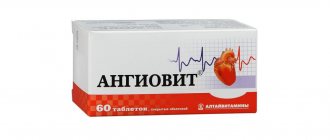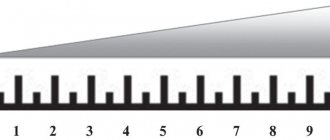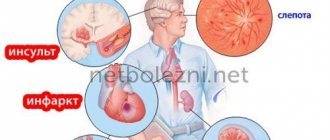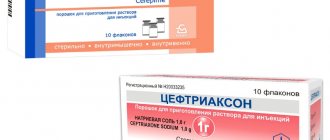Pharmacological properties of the drug Oxibral
Pharmacodynamics . Vincamine has a selective vasoregulatory effect on cerebral vessels, promoting the adaptation of cerebral blood flow to the metabolic needs of the brain. The drug improves brain metabolism by enhancing the oxidation of glucose, thereby increasing energy production and helping to increase the overall activity of the body. Vincamine increases the oxygen supply to neurons in a state of hypoxia. The drug reduces and stabilizes cerebral vascular resistance. Vincamine has the unique ability to normalize cerebral circulation and improve oxygen supply to neurons. It has been proven that the drug is well tolerated by patients, has no biological, hematological toxicity and no side effects on the kidneys and liver. Vincamine, having a diverse effect that increases the functional activity of the brain, is a promising drug for use as a stimulant of intellectual abilities. Pharmacokinetics . Rapidly absorbed from the gastrointestinal tract after oral administration, the half-life is 60–90 minutes, binding to plasma proteins is 64%. Vincamine is completely metabolized in the liver, only 4–6% is excreted unchanged in the urine.
Side effects
When used in accordance with the instructions, Oxibral is well tolerated by patients. Side effects occur extremely rarely and are usually caused by individual hypersensitivity to Vincamine or by exceeding the recommended dosage of Oxybral. However, in medical practice the following side effects have been reported as a result of taking the drug:
- Psychomotor agitation;
- Heart rhythm disturbances;
- Headache;
- Dizziness;
- Symptoms of dyspepsia: heartburn, nausea, dry mouth, stool disorders;
- Allergic reactions: skin itching, urticaria, erythema, angioedema.
To eliminate side effects, reduce the dosage of the drug or interrupt treatment for 1-2 days. In case of allergic reactions, replace Oxibral with another drug of similar effect.
Indications for use of the drug Oxibral
To normalize and adapt cerebral circulation to the metabolic needs of the brain, to regulate, improve and maintain its functions. It is used for the following conditions: memory loss, impaired concentration, diabetic angiopathy, atherosclerotic lesions of cerebral vessels, conditions after traumatic brain injury and acute cerebrovascular accident, cerebral disorders after cerebral ischemia, hypertensive encephalopathy, hearing and vision impairment of vascular origin, disorders orientation in space and time, emotional disturbances resulting from various mental disorders.
Contraindications
The use of Oxibral is contraindicated in the presence of increased individual sensitivity to any of the components of the drug, heart rhythm disturbances, brain tumors, hypokalemia, hypocalcemia, convulsive syndrome of unknown origin. The drug is not recommended for use during pregnancy and breastfeeding, since studies confirming its safety during these periods have not been conducted.
In the case of treatment of concomitant diseases with other drugs while using Oxibral, it is necessary to notify the attending physician, as undesirable interactions are possible.
Special instructions for the use of the drug Oxibral
Do not exceed the recommended dose. Use with caution in patients with hypertension (arterial hypertension) and cardiac dysfunction. Do not use if the QT and there is hypokalemia. The drug contains lactose, which should be taken into account in case of hereditary lactose intolerance. during pregnancy and breastfeeding . Children . Oxibral capsules are not recommended for use in children. Does not affect the ability to drive vehicles and operate other mechanisms , but the state of the central nervous system should be taken into account.
Release form
Oxibral is available in the form of capsules and as a solution for injection.
Long-acting capsules, each containing microgranules of two colors - blue and white.
One capsule contains: vincamine (30g) and excipients: sucrose, lactose, povidone, methacrylic acid copolymer, shellac, gelatin, talc, erythrosine, blue sepsis, indigo carmine. The blister contains 20 capsules.
The solution for injection is available in ampoules of 2 ml, transparent, colorless or slightly yellowish. Each ampoule contains 15 mg of vincamine and excipients: propylene glycol, tartaric acid, sodium metabisulfite, sodium bicarbonate, tartaric acid, purified water for injection. The package contains 5 ampoules.
Nootropic drugs in geriatric practice
U
The increase in the planet's elderly population in recent years due to increasing life expectancy entails an increase in the frequency of neurological diseases developing in old age. The most common among these diseases are neurodegenerative dementias and cognitive impairment associated with cerebrovascular diseases (dyscirculatory encephalopathy).
In the pathogenesis of these diseases, the main role is given to mechanisms such as chronic cerebral ischemia as a result of exposure to various factors, programmed cell death or apoptosis [7], and neuronal degeneration. Recently, increasing attention has been paid to the concept of mixed dementia, according to which both neurodegenerative and ischemic components are present in the development of vascular and neurodegenerative cognitive impairment. Thus, in Alzheimer's disease (AD), concomitant vascular pathology leads to the formation of more severe cognitive deficits and intensification of the degenerative process. In dyscirculatory encephalopathy or vascular dementia, ischemia, in turn, leads to disruption of the functioning of neurons, which can result in neuronal degeneration. Thus, cognitive impairments in the elderly and senile age are realized as a result of a combination of mechanisms that disrupt the metabolism and vital activity of the neuron [2,5,16,18], and one of the ways to treat them may be to reduce the severity of these metabolic cerebral disorders.
Currently, great importance is attached to the use in therapeutic practice for various diseases of the nervous system of nootropic drugs [1,2,4,6,8,10–12,16,21,23], which affect metabolism in various structures that have vasoactive and antihypoxic effect. The modern classification of substances with nootropic effects can be presented as follows.
Classification of substances with nootropic effects
(T.A. Voronina, S.B. Seredenin, 1998) [4].
1. Nootropic drugs with a dominant mnestic effect.
1.1. Pyrrolidone nootropic drugs (racetams), predominantly of metabolic action (piracetam, oxiracetam, aniracetam, etiracetam, isocetam, etc.).
1.2. Cholinesterase drugs.
1.2.1. Strengthening the synthesis of acetylcholine and its release (choline chloride, phosphotidyl-serine, lecithin, acetyl-L-carnitine, etc.).
1.2.2. Agonists of cholinergic receptors (oxotremorine, bethanechol, spiropiperidines, etc.).
1.2.3. Acetylcholinesterase inhibitors (physostigmine, tacrine, amiridine, galantamine, ertastigmine, etc.).
1.2.4. Substances with a mixed mechanism of action (demanol, aceglutamate, nerve growth factor, bifemalan, etc.).
1.3. Neuropeptides and their analogs (ACTH, ebiratide, somatostatin, vasopressin, thyrotropin-releasing hormone, substance P, angiotensin II, cholecystokinin 8, peptide analogues of piracetam, etc.).
1.4. Substances that affect the system of excitatory amino acids (glutamic acid, memantine, milacemide, glycine, D-cycloserine, nooglutyl).
2. Nootropic drugs of mixed action with a wide range of effects (“neuroprotectors”)
.
2.1. Activators of brain metabolism (actovegin, instenon, acetyl-L-carnitine, phosphatidylserine, homopantothenic acid esters, xanthine derivatives, etc.).
2.2. Cerebral vasodilators (vinpocetine, oxybral, nicergoline, vinconate, etc.).
2.3. Calcium antagonists (nimodipine, cinnarizine, flunarizine, etc.).
2.4. Antioxidants (mexidol, exiphon, pyritinol, atherovit, meclofenoxate, tocopherol).
2.5. Substances affecting the GABA system (gammalon, pantogam, picamilon, ligam, nicotinamide, phenibut, phenotropil, sodium hydroxybutyrate, neurobutal, etc.).
2.6. Substances from different groups (ethimizole, orotic acid, methyl glucoorotate, oxymetacyl, beglimin, cerebrocrast, ginseng, instenon, gingko biloba extract, lemongrass, etc.).
Thus, the class of nootropic drugs can include drugs of various pharmacotherapeutic groups that in one way or another affect the metabolism of neurons or hypothetically have a neuroprotective effect. Below we will examine in more detail the mechanisms of action of the most commonly used nootropic drugs in neurological practice.
Pyrrolidone drugs have predominantly metabolic effects
These drugs are most widely known as “nootropics”, since this class includes the drug piracetam, the positive metabolic effect of which on the central nervous system was one of the first to be shown. Pharmacotherapeutic drugs based on the chemical structure of the pyrrolidone ring, which is very similar in chemical structure to g-aminobutyric acid (GABA), have a positive effect on the central nervous system through a number of mechanisms. Thus, a direct effect on energy processes in a neuron by increasing the activity of adenylate cyclase and inhibiting nucleotide phosphatase leads to an intensification of the ATP cycle and thereby normalizes cellular metabolism, which, under conditions of ischemia or neuronal degeneration, is usually significantly reduced. Drugs in this group also stimulate redox processes, increase the utilization of glucose by neurons and have a positive effect on regional cerebral blood flow by reducing the degree of platelet aggregation. The combined effect on cellular metabolism and cerebral blood flow leads to a positive effect of drugs of this group in relation to cognitive functions [1,2,5,6,8,10, 12,20,23]. Thus, one of the therapeutic effects as a result of long-term use of piracetam and its analogues is the improvement of interhemispheric information transfer, which may explain the positive effect of drugs of this pharmacotherapeutic group in relation to speech disorders, in particular, those resulting from a stroke suffered by the patient. Piracetam and its analogues enhance cortico-subcortical impulses, which may result in a decrease in the severity of neurodynamic disorders, impaired attention and an increase in the actual integrative cognitive functions. The mild psychotropic effect of drugs of this pharmacotherapeutic group can also make a positive contribution to improving attention, memory and integrative cerebral processes. The effect of these drugs on the vestibular system is important due to their impact on the mechanisms of signal transmission from sources of visual and proprioceptive sensitivity or a direct effect on the vestibular nuclei of the brain stem. This effect seems to be extremely important in the treatment of discirculatory encephalopathy, including those with predominant suffering of the vertebrobasilar region, and in the treatment of conditions in the clinical picture of which brain stem disorders (in particular, traumatic brain injury) occupy the main place.
In clinical practice, drugs of this pharmacotherapeutic group are used in the recovery period after stroke and traumatic brain injury, in dyscirculatory encephalopathy, post-hypoxic conditions, chronic alcohol or drug intoxication [1,5,11]. Until recently, attempts were made to use piracetam and its analogues in the treatment of degenerative dementia. Unfortunately, most of the placebo-controlled clinical trials have not shown a significant positive effect of piracetam and similar drugs on cognitive impairment and the rate of its progression in AD and other neurodegenerative dementias [5,8,23].
The new generation of drugs of this pharmacotherapeutic group is represented mainly by combination drugs
, the structure of which combines a nootropic and vasoactive substance. Vasoactive drugs, reducing the resistance of cerebral vessels, cause an increase in both total hemispheric and regional blood flow. This promotes better oxygenation of the brain, normalization of metabolic processes and improvement of the condition of patients. When using vasoactive drugs, the correct choice of drug is of great importance. Thus, these drugs (especially in large doses), along with the dilation of cerebral vessels, can significantly reduce total peripheral resistance and reduce systemic blood pressure, which in conditions of chronic cerebral circulatory failure can lead to the progression of ischemic damage to brain tissue. Therefore, to correct cerebral vascular disorders, it is desirable to use drugs that, in therapeutic doses, do not affect central hemodynamic parameters.
One of the drugs that is a combination of nootropic and vasoactive substances is Phezam
. This is a combination drug containing 400 mg of piracetam and 25 mg of cinnarizine. The combination of these components enhances the antihypoxic effect and reduces the tone of the smooth muscles of the brain vessels. Phezam has moderate antiplatelet activity, stimulates metabolic processes in the central nervous system, increases the integrative abilities of the brain, improves memory, and facilitates the learning process. This drug is successfully used for chronic cerebral circulatory failure caused by atherosclerosis of cerebral vessels or a stroke, brain injury, alcohol or drug intoxication, as well as for disorders of memory, concentration and functions of the vestibular apparatus.
This drug is prescribed with caution to people suffering from liver and kidney diseases.
The drug is not used in patients with parkinsonism. Because the dyes in the tablet coating contain iodine, the results of studies using radioactive iodine may be distorted.
When prescribing treatment with Phezam, it is imperative to focus the patient’s attention on the fact that when taken simultaneously, it is possible to enhance the sedative effect of drugs that depress the central nervous system, tricyclic antidepressants and alcohol, as well as nootropic and antihypertensive drugs. Vasodilators enhance the effect of the drug, and hypertensive drugs weaken it.
Fezam is ideal in cases where the use of piracetam alone causes tension and insomnia in the patient.
When Phezam is used in recommended doses, it is possible to drive vehicles and operate machinery. This benefit is especially important for the working patient population.
Fezam is recommended for adults to take 1-2 capsules 3 times a day, for children – 1-2 times a day. The duration of use is determined individually and is 1.5–3 months.
Cholinesterase drugs
Acetylcholine deficiency underlies cognitive impairment of both neurodegenerative and vascular nature. Cholinergic drugs are currently the main pharmacotherapeutic group used for the symptomatic treatment of asthma [2,5,8,9,21]. It should be noted that these drugs in the early stages of the disease can also have a pathogenetic effect, since the initial death of neurons in the basal nucleus of Meynert and the accompanying cholinergic deficiency lead to deafferentation degeneration of neurons in the temporo-parietal-occipital cortex. A possible neuroprotective effect of these drugs is also suggested, since they may have an indirect effect on amyloidogenesis [11,15].
Today in the treatment of asthma they use
mainly
cholinesterase inhibitors
. The latest generation of these drugs has a prolonged effect and can be prescribed once (donepezil) or twice (rivastigmine, galantamine) once a day.
One of the modern cholinergic drugs for the treatment of asthma is rivastigmine.
[21]. The action of the drug is carried out through the blockade of acetylcholinesterase and butyrylcholinesterase - enzymes that destroy acetylcholine in the synaptic space. The half-life of the drug is about 12 hours, so it can be administered twice a day.
When starting treatment with rivastigmine, the dose of the drug should be increased gradually to ensure better tolerability of the drug. The standard regimen is to increase the dose of rivastigmine by 3 mg per day every two weeks. The minimum daily dose is 3 mg, the maximum is 12 mg. As a rule, the dose of the drug is increased until it is well tolerated by patients. The most common adverse reactions are nausea and vomiting. These reactions are caused directly by the cholinergic effect of the drug, although they may also have a central genesis. The drug is metabolized by the liver and has some hepatotoxic effects, which is why when treating with rivastigmine it is necessary to control the level of hepatic transaminases in the blood.
Treatment with rivastigmine, like other cholinergic drugs, should be carried out continuously, since sudden withdrawal of the drug can lead to a sharp increase in cognitive deficit. It should be noted that the positive effect of the drug, despite the progression of the disease, persists for quite a long time.
However, not all asthma patients respond to treatment with rivastigmine. On average, a therapeutic effect is observed in 40–50% of patients. Perhaps the lack of effect from prescribing cholinergic drugs is due to the genetic heterogeneity of asthma. In any case, the range of symptoms that can be reliably treated with cholinergic drugs in asthma has yet to be delineated.
Rivastigmine may be effective not only for asthma. In particular, with vascular dementia, long-term use of this drug (12 months or more) also shows a positive effect in the form of a decrease in the severity of cognitive impairment. Some researchers indicate that rivastigmine, in addition to its cholinergic effect, may also have a metabolic effect as a result of an increase in cerebral blood flow in the frontal, temporal and occipital regions [22]. Thus, it can be assumed that rivastigmine has a positive effect on cerebral circulation and, accordingly, can be used for cognitive impairment that develops as a result of cerebral dyscirculation.
Activators of cerebral metabolism
The main property of these drugs is an increase in neuronal metabolism under conditions unfavorable for cellular activity
.
Drugs that activate cerebral metabolism increase neuron survival under ischemic conditions, enhance the utilization of glucose by cells and, accordingly, can have a beneficial effect on both the severity of cognitive impairment and the rate of disease progression. This class of nootropics includes drugs from various pharmacotherapeutic groups. The most commonly used activators of cerebral metabolism are Actovegin, Instenon, Cerebrolysin
. Instenon is a combined drug consisting of vascular (etaphylline) and neurotropic (hexabindin) components; it also contains etamivan, which supposedly has an activating effect on nonspecific cerebral systems [2,6,11]. When taking this drug, there is an increase in the transport and consumption of glucose and oxygen by cerebral neurons due to stimulation of anaerobic oxidation, activation of microcirculation and cerebral circulation. The drug does not have a significant effect on systemic hemodynamic parameters, which is its undoubted advantage.
Actovegin is an oligopeptide drug containing nucleic acid derivatives, oligosaccharides and microelements. The mechanism of action of Actovegin is to improve aerobic glycolysis by increasing the supply and utilization of glucose and oxygen [5,6,12]. This leads to activation of Krebs cycle enzymes, acceleration of lactate breakdown, prevention of the development of lactic acidosis, stimulation of ATP formation, normalization of energy metabolism in conditions of its deficiency, improvement of metabolism and cell activity. Cerebrolysin is also a peptide drug and has a mechanism of action similar to Actovegin.
Drugs that are activators of cerebral metabolism are used in the treatment of acute and chronic cerebrovascular diseases, traumatic brain injuries, as well as for peripheral circulatory disorders. Currently, their effectiveness in dyscirculatory encephalopathy has been convincingly demonstrated [2,5,10]. Unfortunately, the results of most clinical trials conducted indicate that these drugs do not have a significant effect on the severity and rate of progression of cognitive impairment in degenerative dementias, in particular in AD [5,8,16].
Calcium channel blockers
Calcium channel blockers exert their action directly through the stabilization of cell membranes. As is known, under conditions of apoptosis or cerebral hypoxia, activation of glutamate leads to subsequent stimulation of NMDA receptors, opening of calcium channels and increased calcium entry into the neuron [7]. The resulting membrane charge inversion leads to membrane depolarization and subsequent cell death. Thus, drugs that block calcium neuronal receptors should increase the resistance of neurons to hypoxia and promote the survival of the neuronal population both in vascular and metabolic, as well as in neurodegenerative processes [6,12]. A number of clinical studies have shown the effectiveness of these drugs in dyscirculatory encephalopathy [6]. There is evidence of the positive effect of these drugs in neurodegenerative dementia [11]. It should be noted that these results are not confirmed by all researchers: a number of clinical trials have not shown any positive effect on cognitive functions in both vascular and neurodegenerative cognitive disorders [2,5,8,12,23] . Undoubtedly, the supposed nootropic effect of calcium channel blockers needs further research and confirmation.
Drugs that have a neuroprotective effect
Currently, attempts are being made to use drugs from a wide variety of pharmacotherapeutic groups in the treatment of cognitive impairment, presumably having a neuroprotective effect. Thus, the neuroprotective effect of estrogens is discussed
. The results of clinical trials have shown that estrogen treatment can be effective both in cognitive impairment that has developed as a result of neurodegenerative pathology, and in cognitive impairment of vascular origin. Moreover, in the first case, a slowdown in the progression of the disease may be observed [11], while in the second, a positive effect is realized as a result of a decrease in the severity of hyperlipidemia. Clinical trials evaluating the effectiveness of tocopherol, selegiline and ginkgo biloba preparations have shown that these drugs can also have some effect on the severity of cognitive impairment in AD and dyscirculatory encephalopathy [5]. However, in AD, this effect is not so pronounced and we have to talk not about the treatment of cognitive impairment, but only about a slight slowdown in the progression of the disease. There is data on the use of Cerebrolysin in high doses (20–30 ml intravenously, 20–40 injections), according to which this therapy can reduce the severity of cognitive impairment both in AD and in cognitive impairment of vascular origin [10]. It is assumed that Cerebrolysin, along with systemic metabolic and antioxidant effects, also has a neuroprotective effect and helps reduce amyloidogenesis [10].
, NMDA receptor antagonists are actively used in the treatment of cognitive impairment in the elderly.
[3,8,9,13,14,17,19]. In addition to the direct effect on NMDA receptors and, accordingly, slowing the progression of cognitive impairment as a result of inhibition of the mechanism of apoptosis or programmed cell death [7], drugs of this group interact with various mediator systems of the brain, which also manifests a positive effect on cognitive functions. This feature, namely the effect of NMDA receptor antagonists on the metabolism of acetylcholine, norepinephrine and dopamine, seems to be the most interesting. Thus, an increase in the level of cerebral acetylcholine is directly related to a decrease in the severity of memory, speech and attention disorders, while a positive effect on dopaminergic systems can lead to a decrease in the severity of neurodynamic functions and intellectual impairment. The complexity of the action of drugs of this pharmacotherapeutic group suggests that they can be effective in cognitive impairment of both vascular and neurodegenerative etiology.
The second aspect of the therapeutic activity of NMDA receptor antagonists is their neuroprotective effect [8,17]. This effect is a direct result of blockade of NMDA receptors, closure of ionotrophic channels and, accordingly, stabilization of the cell membrane, which protects cells from death. Preventive administration of drugs of this pharmacotherapeutic group in the experiment reduced the ischemic penumbra zone, the severity of cerebral edema, and also reduced the area of the ischemic focus itself [13]. A similar result was obtained in other models of brain damage.
Thus, the range of drugs with nootropic effects is quite wide.
It should be emphasized once again that the greatest effectiveness of these drugs is observed in mild cognitive impairment, mainly of vascular origin. Despite the abundance of nootropic drugs, the treatment of vascular dementia seems more complex. Cognitive impairment in neurodegenerative dementias in some cases respond positively to treatment with cholinergic drugs and NMDA receptor antagonists. The use of drugs from other pharmacotherapeutic groups for neurodegenerative dementia, as a rule, does not give the desired result. Literature:
1. A.S. Avedisova, R.V. Akhapkin, V.I. Akhapkina, et al. – Analysis of foreign studies of nootropic drugs (using the example of piracetam). – Russian Psychiatric Journal. – 2001. – No. 1. – P. 57–63.
2. I.V. Damulin. Alzheimer's disease and vascular dementia. – Moscow, 2002. – 85 p.
3. I.V. Damulin. New neuroprotective and therapeutic strategy for dementia: NMDA receptor antagonist Akatinol Memantine. – Russian. honey. magazine –2001. –T.9, No. 25. –pp.1178–1182.
4. N.N. Zavadenko. – Nootropic drugs in the practice of pediatricians and pediatric neurologists. Guidelines. – RKI Sovero-press. - Moscow. – 2003 – 25 p.
5. V.V. Zakharov, N.N. Yakhno. – Memory impairment. - Moscow. – Geotar-Med. – 2003. – 158 p.
6. S.V. Kotov, E.V. Isakova, A.A. Ryabtseva et al. – Complex therapy of chronic cerebral ischemia. - Moscow. – RKI Sovero-press. – 2001. – 96 p.
7. Korshunov A.M., Preobrazhenskaya I.S. Programmed cell death (apoptosis) // Neurological Journal. – 1998. – N. 1. – pp. 40–47.
8. I.S. Preobrazhenskaya, N.N. Yakhno. Alzheimer's disease: pathogenesis, clinical picture, treatment. – Russian medical journal. – 2002. – T. 10. – No. 25. – P. 1143–1147.
9. N.N. Yakhno, I.V. Damulin, I.S. Preobrazhenskaya, E.A. Mkhitaryan. – Alzheimer's disease and dementia with Lewy bodies: some aspects of the clinic, diagnosis and treatment. – Russian medical journal. – 2003. – T.11. – No. 10. – p. 567–570.
10. Alvarez XA, Ruether E., Moessler H.. Efficacy of cerebrolysin in moderate to moderately severe Alzheimer's disease. In: Research and practice in Alzheimer's disease. – Volume 5. – Serdi Publishing (Paris). – Springer Publishing Company (NY). – 2001. – P. 179–186.
11. Brodaty H., Sachdev PS. Drugs for the prevention and treatment of Alzheimer's disease./Med. J. Aust. – 1997. – V. 167. – P. 8. – P. 447–449, 452.
12. Bullock R. New drugs for Alzheimer's disease and other dementias./Br. J. Psychiatry. – 2002. – V. 180. – P. 135–139.
13. Danysz W., Parsons CG, Quack G.. NMDA channel blockers: memantine and amino–alkylcyclohexanes – in vitro characterization./Amino Acids. – 2000 – V. 19. – P. 167–172.
14. Dogan A., Eras MA, Raghavendra Rao VA, et al. Protective effects of memantine against ischemia–reperfusion injury in spontaneously hypertensive rats. / Acta Neurochir. (Wien). – 1999. – V. 141. – P. 1107–1113.
15. Francis PT, Palmer AM, Snape M., Wilcock GK The cholinergic hypothesis of Alzheimer's disease: a review of progress. //J. Neurol. Neurosurg. Psychiat. –1999. –Vol.66. –P.137–147.
16. Grundman M.. Current therapeutic advances in Alzheimer's disease. In: Research and practice in Alzheimer's disease. – Volume 5. – Serdi Publishing (Paris). – Springer Publishing Company (NY). – 2001. – P. 172–177.
17. Marvanova M., Lakso M., Pirhonen J., et al. E.
The neuroprotective agent memantine induces brain–derived neurotrophic factor and trkB receptor expression in rat brain./Mol. Cel. Neurosci. – 2001. – V. 18. – N. 3. – P. 247–258.
18. Perlick D., Mattis S./Neuropsychological assessment in chronic care settings: potential utility and special considerations for evaluating dementia in the elderly.//Alzheimer Dis. Assoc. Discord. – 1994. – V. 8. – Suppl 1. – S 209–213.
19. Sahin K., Stoeffler A., Furtuna P. et al. Dementia severity and the magnitude of cognitive benefit by memantine treatment. A subgroup analysis of two placebo–controlled clinical trials in vascular dementia. //Neurobiol. Aging. –2000. –Vol.21. –P.S27.
20. Small BJ, Fratiglioni L, Viitanen M et al. Time course of preclinical cognitive deficits in Alzheimer's disease. In: Research and practice in Alzheimer's disease. – Volume 5. – Serdi Publishing (Paris). – Springer Publishing Company (NY). – 2001. – P. 29–34.
21. Vellas B., Messina J., Hartman R., et al. Multi–dimensionality of treatment benefits in Alzheimer's disease: investigating the correlation between activities of daily living and cognition in patients treated with rivastigmine. In: Research and practice in Alzheimer's disease. – Volume 5. – Serdi Publishing (Paris). – Springer Publishing Company (NY). – 2001. – P. 193–204.
22. Venneri A, Shanks MF, Staff RT, et al. Cerebral blood flow and cognitive responses to rivastigmine treatment in Alzheimer's disease./Neuroreport. – 2002. – V. 13. – N. 1. – P. 83–87.
23. Wilkinson D. Drugs for treatment of Alzheimer's disease./Int. J. Clin. Pract. – 2001. – V. 55. – N. 2. – P. 129–134.







